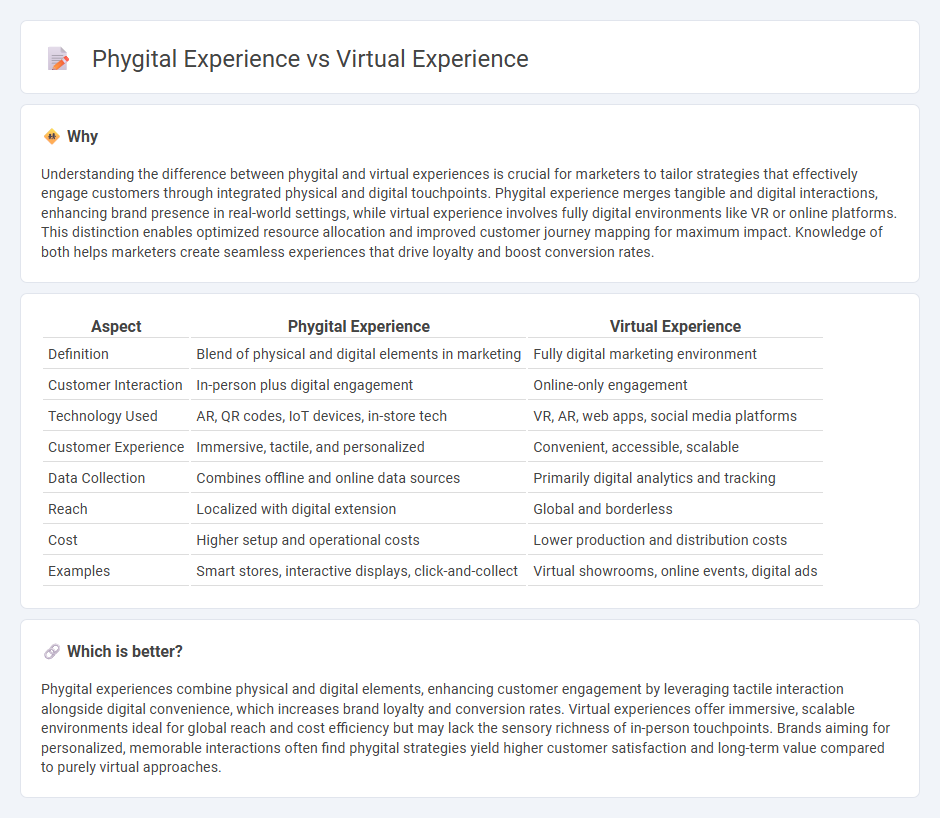
Phygital marketing blends physical and digital experiences to create immersive consumer interactions, leveraging technologies like augmented reality and IoT to enhance real-world engagement. Virtual experiences occur entirely in digital environments, utilizing VR, 3D simulations, and online platforms to engage audiences remotely. Explore how integrating phygital and virtual strategies can transform your marketing approach and boost customer satisfaction.
Why it is important
Understanding the difference between phygital and virtual experiences is crucial for marketers to tailor strategies that effectively engage customers through integrated physical and digital touchpoints. Phygital experience merges tangible and digital interactions, enhancing brand presence in real-world settings, while virtual experience involves fully digital environments like VR or online platforms. This distinction enables optimized resource allocation and improved customer journey mapping for maximum impact. Knowledge of both helps marketers create seamless experiences that drive loyalty and boost conversion rates.
Comparison Table
| Aspect | Phygital Experience | Virtual Experience |
|---|---|---|
| Definition | Blend of physical and digital elements in marketing | Fully digital marketing environment |
| Customer Interaction | In-person plus digital engagement | Online-only engagement |
| Technology Used | AR, QR codes, IoT devices, in-store tech | VR, AR, web apps, social media platforms |
| Customer Experience | Immersive, tactile, and personalized | Convenient, accessible, scalable |
| Data Collection | Combines offline and online data sources | Primarily digital analytics and tracking |
| Reach | Localized with digital extension | Global and borderless |
| Cost | Higher setup and operational costs | Lower production and distribution costs |
| Examples | Smart stores, interactive displays, click-and-collect | Virtual showrooms, online events, digital ads |
Which is better?
Phygital experiences combine physical and digital elements, enhancing customer engagement by leveraging tactile interaction alongside digital convenience, which increases brand loyalty and conversion rates. Virtual experiences offer immersive, scalable environments ideal for global reach and cost efficiency but may lack the sensory richness of in-person touchpoints. Brands aiming for personalized, memorable interactions often find phygital strategies yield higher customer satisfaction and long-term value compared to purely virtual approaches.
Connection
Phygital experience merges physical and digital interactions to create immersive marketing campaigns that engage customers through multiple touchpoints. Virtual experiences utilize augmented reality (AR) and virtual reality (VR) technologies, enhancing phygital strategies by offering seamless, interactive environments that bridge real-world and online engagement. This connection amplifies brand presence, fosters personalized customer journeys, and drives higher conversion rates across both digital and physical channels.
Key Terms
Immersion
Virtual experiences leverage fully digital environments powered by VR and AR technologies to create immersive, interactive settings that engage multiple senses. Phygital experiences blend physical elements with digital enhancements, offering tangible interactions combined with augmented realities that deepen user engagement. Explore how each approach transforms consumer immersion to enhance brand storytelling and customer satisfaction.
Omnichannel
Virtual experiences leverage digital platforms to engage users remotely, providing convenience and accessibility across various devices. Phygital experiences blend physical environments with digital technologies, creating immersive, interactive touchpoints that enhance customer engagement in-store and online simultaneously. Explore how integrating omnichannel strategies can optimize both virtual and phygital experiences for seamless customer journeys.
User Engagement
Virtual experiences immerse users in fully digital environments utilizing VR, AR, or online platforms to enhance interaction and engagement metrics such as session duration and interaction depth. Phygital experiences blend physical and digital elements, combining tangible touchpoints with digital overlays, leading to increased sensory stimulation and stronger emotional connections, which drive higher recall and satisfaction rates. Explore further to understand how these approaches redefine user engagement strategies across industries.
Source and External Links
Virtual reality - Wikipedia - Comprehensive guide covering forms, methods, and technology behind simulated 3D experiences, from desktop-based simulations to fully immersive, tracked environments.
Artsteps | Make your own VR Exhibitions - Free online platform to create and share custom virtual exhibitions using images, videos, 3D models, music, and interactivity, fostering community and discovery.
Sandbox VR | Immersive Virtual Reality Experiences - Offers group-based, motion capture, and haptic-equipped VR adventures for highly immersive, social virtual experiences.
 dowidth.com
dowidth.com